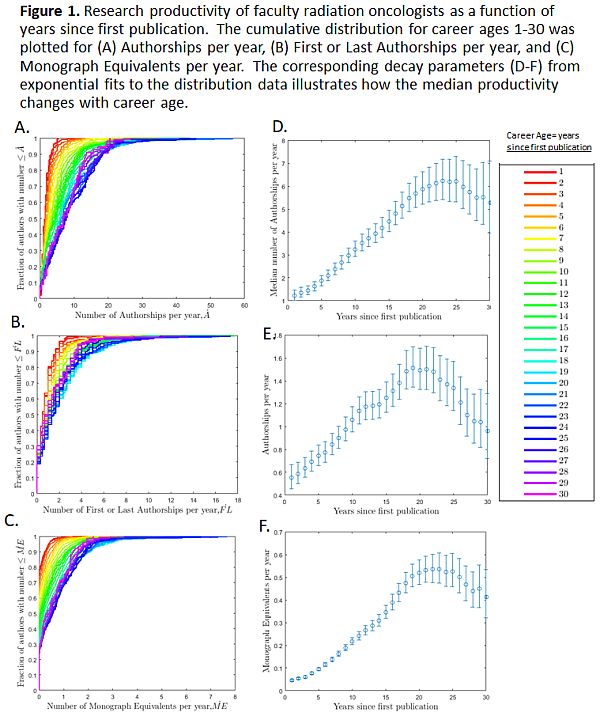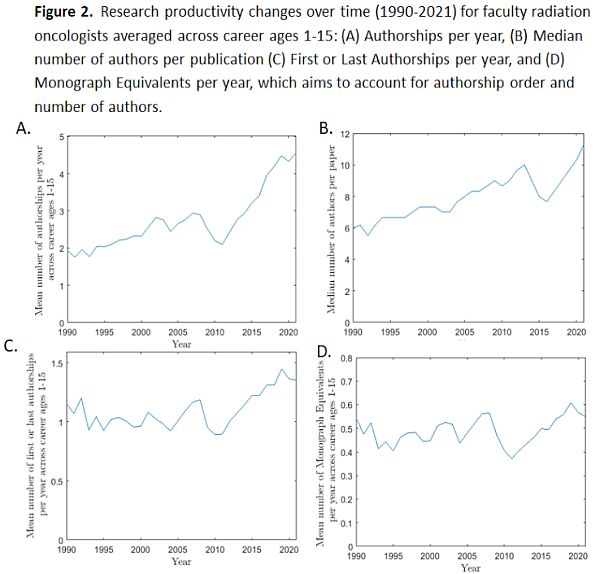On the research productivity of academic radiation oncologists and their performance over time
PO-1074
Abstract
On the research productivity of academic radiation oncologists and their performance over time
Authors: Christopher Deufel1, John Lucido1, Daniel Ma1, Sara A. Hylwa2, Douglas Moseley1
1Mayo Clinic, Radiation Oncology, Rochester, USA; 2Hennepin Healthcare, Dermatology, Minneapolis, USA
Show Affiliations
Hide Affiliations
Purpose or Objective
The quantitative measurement of academic productivity for radiation oncology faculty is increasingly used for staff performance evaluation. This study establishes bibliometric performance as a function of career age for faculty radiation oncologists from highly ranked medical centers. The findings reveal patterns in research productivity of the field over time, as well as over the arc of a career, and include data tables that can be used to calculate the age-adjusted percentile ranking for each year of a faculty member’s career.
Material and Methods
Peer-reviewed original articles between the years 1970-2021 (n= 20,447) were obtained using Scopus for the radiation oncology faculty (n= 348) listed on department webpages for the top ten cancer hospitals ranked by US News and World Report. Bibliometric rates were calculated for each faculty member after applying a three-year smoothing window for the following metrics: the number of authorships per year (A), authorships per year where the individual was the first or last author (FL), monograph equivalentsª per year defined as the equivalent of the author’s publications in monographs (ME ), Hirsch’s h-index, and ha-indexª which is an analog to the Hirsch-index where monograph equivalents are used in place of publications. The results were grouped according to years since a faculty members’ initial publication, and a cumulative distribution function was fit for each grouping. The impact of hyper-authorship and real productivity changes over time were explored by calculating the mean bibliometrics across career ages 1 to 15 for the years 1990-2021.
ªAziz and Rozing. “Profit (p)-index:The Degrees to Which Authors Profit from Co-Authors”.2013 https://doi.org/10.1371/journal.pone.0059814
Results
Over the course of a career, the average faculty radiation oncologist’s bibliometric productivity rate increased by as much as 10x and peaked 20 to 25 years after their first publication (Figure 1). The measured median (50th percentile) bibliometrics at career ages of 1, 10, 20, and 30 years were A = [1.2,3.2, 5.9, and 5.3] per year, FL = [0.5, 1.1, 1.5, 1.0] per year, and ME = [0.05, 0.2, 0.5, 0.4] per year. H-index and ha-index increased linearly with career age with slopes of 1.5 and 0.55 per year, respectively. When comparing research productivity between 1990 and 2021 (Figure 2), A increased by 236%, FL increased by 17%, and ME was unchanged.


Conclusion
Over the course of an individual career, the bibliometrics of the average faculty radiation oncologist increased steadily and peaked after 20-25 years before diminishing until retirement. The distribution of bibliometrics can be used to generate tables for calculating career age-adjusted percentile performance of any faculty member. As a field, radiation oncology faculty have seen large increases in the rate of authorships since 1990, however no increase was observed in research productivity when using a bibliometric that accounts for number and order of authors.